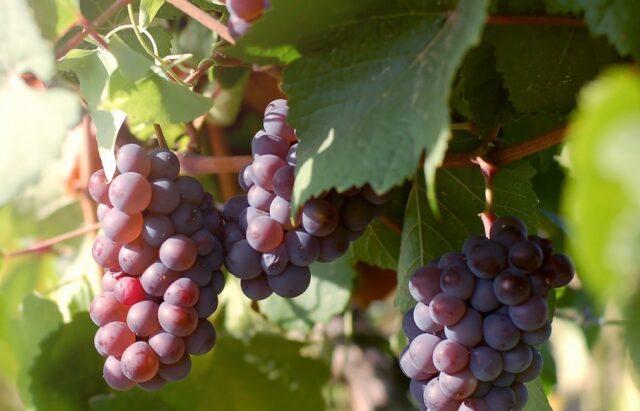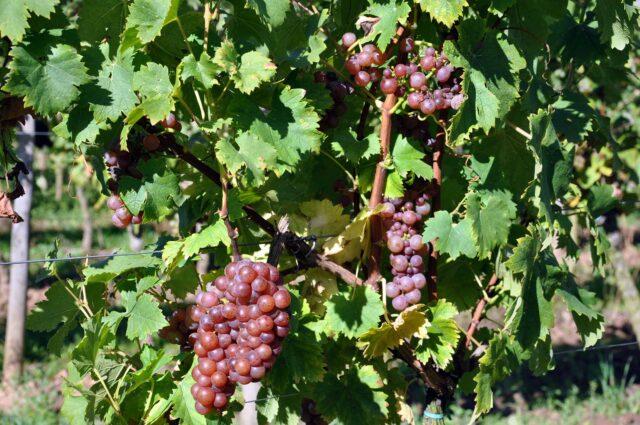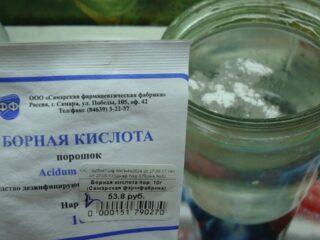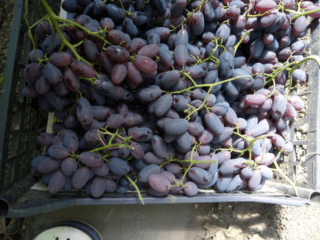Content
Pink Muscat grape is a time-tested table variety. It is characterized by early ripeness, large fruit and high sugar content in the berries. Pink Muscat is of particular value to winemakers. But to get a good harvest every year, it is necessary to take into account the basic requirements of the crop and provide adequate care. These grapes are suitable for cultivation on an industrial scale and amateur gardening.

Muscat pink is listed as a Greek variety
History of selection
The first mention of this type of culture appeared several centuries ago. It is believed that it was isolated from Muscat white as a result of a bud deviation. It is not known for certain who started this table grape variety. Its homeland is considered to be the southwestern part of Europe.
Description of grape variety Muscat pink
This grape is in many ways similar in appearance to White Muscat.But there are also significant differences between them that need to be paid attention to.
Bunches
Muscat pink is characterized by medium-sized clusters, shaped like a cylinder or cone. Their length reaches 18 cm, and their diameter is about 10 cm. The berries are firmly held on the stalk. The bunches are moderately loose. Their average weight is 108-204 g.
Berries
The fruits of this species are larger than those of White Muscat. The berries are round, 17-18 mm in size. When ripe, they acquire a dark red color, which indicates the need for harvesting. The pulp is juicy and tender. The skin of the berries is strong, but not very dense; when eaten, it is practically not felt.
Grapes are often covered with a wax coating. Each of them can have up to four seeds.
Vine
Muscat rose bushes are not tall and have a moderate growth rate. Young shoots are covered with edges and have a pink crown with a noticeable red tint. After ripening, the color changes from green to light brown. But at the same time, the nodules remain darker. The development of second-order shoots is slow. Often they do not have time to grow during the season.
The leaves of this species are practically no different from white Muscat. The plates are five-lobed, large or medium-sized, round in shape, with slight rugosity along the edge. On the reverse side they are slightly pubescent. The leaves are directed downwards, but at the same time their crown is curved and sticks up. They are green in color.

The ripening of first-order shoots in this variety is good or satisfactory
Characteristic
To successfully grow Muscat pink, you need to take into account its main characteristics.Taking this into account, it will be much easier to provide proper care for the grapes, which will allow you to get maximum productivity from the variety.
Ripening period
This species belongs to the early category. The growing season from bud break to berry ripening is 120-140 days, depending on the growing region. The harvest reaches harvest maturity in the third ten days of September.
Productivity
Productivity is average, but higher than that of its white counterpart. It is 60-80.3 c/ha. Low-yielding clones are found in plantings of this grape. The mass fraction of fruitless shoots on a bush does not exceed 10-25%.
Taste
The berries are sweet in taste and have a distinct nutmeg hue. The tasting rating of the variety on a ten-point scale is 8.2. The sugar content in ripe grapes reaches 35%.
Growing regions
Pink nutmeg is grown all over the world. It is distributed mainly in southern European countries, such as Italy, Greece, Spain, France. Pink Muscat is also grown in Kazakhstan and Azerbaijan.
The variety is also widespread on the Crimean Peninsula, in particular in the Yalta, Alushta, Saki, and Evpatoria regions.
Frost resistance
This variety is sensitive to cold. The vine can withstand temperature drops of no more than -23 °C. Pink Muscat also suffers from late spring frosts, and in order to protect the bushes, they need to be covered with agrofibre in several layers when there is a threat of a sharp temperature change.
Drought resistance
Pink nutmeg, unlike its white counterpart, reacts poorly to lack of moisture in the soil.Therefore, during periods of drought it needs regular watering.
Resistance to diseases and pests
This variety is susceptible to mildew and oidium. Gray rot appears in a third of the bushes, and downy mildew appears in 40%. Pests, namely leaf rollers and phylloxera, can also cause significant damage to grapes.

Pink Muscat berries may rot during periods of heavy rainfall
Methods of application
The main purpose of this grape is the production of Muscat liqueur wines. High quality drinks are prepared on its basis. They are distinguished by the aroma of tea rose and have a unique rich taste. Raw materials grown in the southern part of the Crimean Peninsula on slate soil are especially valued. In this case, the sugar content of the berries reaches its maximum level.
Pink nutmeg is also used for making jams; due to its pleasant taste, it is also suitable for fresh consumption.
Advantages and disadvantages
Pink nutmeg, like other types of crops, has strengths and weaknesses. And for its successful cultivation, you need to familiarize yourself with them in advance.

The juice yield from grapes is 63-70%
Main advantages:
- early ripeness;
- high sugar accumulation in fruits;
- versatility of application;
- pleasant taste and aroma.
Flaws:
- affected by oidium, mildew;
- susceptibility to attack by leaf rollers, phylloxera;
- suffers from spring frosts;
- sensitive to lack of moisture.
Features of growing Muscat pink grapes
When growing this variety, it is recommended to form the vine without a trunk.The shoots should be tied to the trellis in a fan fashion or in four sleeves 60 cm long.
For Muscat Rose, you need to choose sunny areas, protected from cold gusts of wind. In regions with little snow, it should be planted in trenches or deep holes. In areas with cold and short summers, it is recommended to plant in high ridges.
The soil in the area where the grapes will grow must be well drained. And the acidity level is neutral. A groundwater level of at least 1.5 m is acceptable. Planting is best done in the spring.
The seedling needs to be watered regularly for the first two years until its root system grows. In this case, water should be poured between the rows. Moisturize once a week. And ten days before harvest, stop irrigation completely. In the spring, during the period of active growth of green mass, Pink Muscat needs to be fertilized with organic matter twice every two weeks. For this you can use chicken manure 1:15 or mullein 1:10.
In the future, superphosphate (40 g) and potassium sulfide (30 g) should be used, scattering granules at the base of the bushes, with further incorporation into the soil and watering. The frequency of application is once a month.
Young seedlings should be pruned when their side shoots reach a length of 12 cm. In the first procedure, four stems are left on the main one and two on the cuttings. Bushes need to be pruned annually in the fall. At this time, all mature stems should be shortened by 1/3, and young stems that are not yet strong should be completely cut off. You should also clear the bushes of broken and damaged shoots.
During the ripening period of the bunches, you need to pinch the tops of the shoots.Mature grapes should have no more than 30 branches, otherwise the berries will become smaller.

The Muscat rose crop ripens evenly
In autumn, at the base of the bush, you need to lay mulch in a layer of 8-10 cm. For this, you can use humus and peat. It is recommended to remove the grapevine from its support, bend it to the ground and insulate it with spruce branches on top.
Conclusion
Pink Muscat grapes are an ideal variety for making wine, both industrially and at home. But to obtain a stable harvest, preventive treatments with fungicides cannot be ignored every year. Otherwise, oidium and mildew can nullify all the efforts of the gardener.
Reviews of Muscat pink grapes








